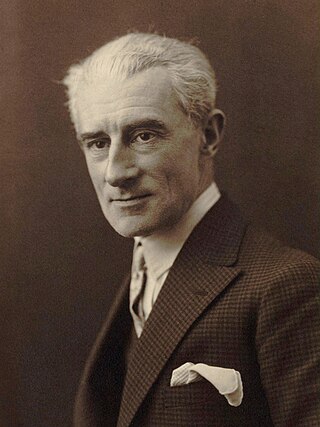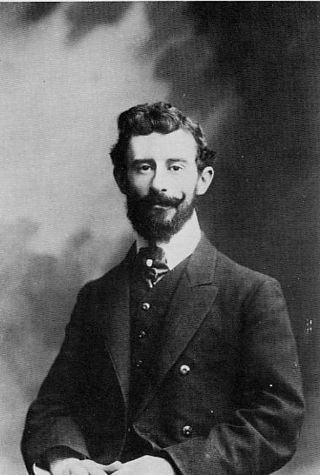
Menuet sur le nom d'Haydn is a minuet for solo piano written by Maurice Ravel in 1909 to mark the centenary of Joseph Haydn's death. [1]

Menuet sur le nom d'Haydn is a minuet for solo piano written by Maurice Ravel in 1909 to mark the centenary of Joseph Haydn's death. [1]
The piece is only 54 bars long and lasts for about a minute and a half. The theme is based on Haydn's own name as a five-note motif. The letter H represents B natural, A and D representing their respective pitches, Y as D natural and N as G natural. In the score, the use of this motif is marked using their letters including several inverted and retrograde versions. [2]
This work came about as a result of a commission by the Revue musicale mensuelle de la Société Internationale de Musique. [3] In total, six composers were commissioned: Maurice Ravel, ('Menuet sur le nom d'Haydn'), Claude Debussy ('Hommage à Haydn'), Vincent d'Indy, Paul Dukas ('Prélude Élégiaque'), Reynaldo Hahn ('Theme Varié sur le nom de Haydn'), and Charles-Marie Widor ('Fugue sur le nom d'Haydn').
Each composer was given the same task: to write a piece based on the musical equivalent of Haydn's name.

Joseph Maurice Ravel was a French composer, pianist and conductor. He is often associated with Impressionism along with his elder contemporary Claude Debussy, although both composers rejected the term. In the 1920s and 1930s Ravel was internationally regarded as France's greatest living composer.

Boléro is a 1928 work for large orchestra by French composer Maurice Ravel. It is one of Ravel's most famous compositions. It was also one of his last completed works before illness diminished his ability to write music.

Le Tombeau de Couperin is a suite for solo piano by Maurice Ravel, composed between 1914 and 1917. The piece is in six movements, based on those of a traditional Baroque suite. Each movement is dedicated to the memory of a friend of the composer who had died fighting in World War I. Ravel also produced an orchestral version of the work in 1919, although this omitted two of the original movements.

Claude Antoine Jean Georges Napoléon Coste was a French classical guitarist and composer.

Jeux d'eau is a piece for solo piano by Maurice Ravel, composed in 1901 and given its first public performance the following year. The title is variously translated as "Fountains", "Playing Water" or literally "Water Games". At the time of writing Jeux d'eau, Ravel was a student of Gabriel Fauré, to whom the piece is dedicated. The work is in a single movement, typically lasting between four and half and six minutes in performance.

Miroirs is a five-movement suite for solo piano written by French composer Maurice Ravel between 1904 and 1905. First performed by Ricardo Viñes in 1906, Miroirs contains five movements, each dedicated to a fellow member of the French avant-garde artist group Les Apaches.
Jean René Désiré Françaix was a French neoclassical composer, pianist, and orchestrator, known for his prolific output and vibrant style.

The Piano Concerto for the Left Hand in D major was composed by Maurice Ravel between 1929 and 1930, concurrently with his Piano Concerto in G major. The piece was commissioned by Paul Wittgenstein, a concert pianist who had lost his right arm in the First World War.

Pavane pour une infante défunte is a work for solo piano by Maurice Ravel, written in 1899 while the French composer was studying at the Conservatoire de Paris under Gabriel Fauré. Ravel published an orchestral version in 1910 using two flutes, an oboe, two clarinets, two bassoons, two horns, harp, and strings.
Menuet antique is a piece for solo piano composed by Maurice Ravel. The original piano version was written in 1895 and orchestrated by the composer in 1929. Ravel wrote the piece to pay tribute to Emmanuel Chabrier, who had welcomed his early works and helped to establish his musical reputation.

Sonatine is a piano work written by Maurice Ravel. Although Ravel wrote in his autobiography that he wrote the sonatina after his piano suite Miroirs, it seems to have been written between 1903 and 1905. He most likely referred to the dates he finished both of the works.

La valse, poème chorégraphique pour orchestre, is a work written by Maurice Ravel between February 1919 and 1920; it was first performed on 12 December 1920 in Paris. It was conceived as a ballet but is now more often heard as a concert work.

Théodore Lack was a French pianist and composer.
Shéhérazade is the title of two works by the French composer Maurice Ravel. Both have their origins in the composer's fascination with Scheherazade, the heroine and narrator of The Arabian Nights. The first work, an overture (1898), Ravel's earliest surviving orchestral piece, was not well received at its premiere and has not subsequently been among his most popular works. Four years later he had a much greater success with a song cycle with the same title, which has remained a standard repertoire piece and has been recorded many times.
In classical music, it is relatively rare for a work to be written in collaboration by multiple composers. This contrasts with popular music, where it is common for more than one person to contribute to the music for a song. Nevertheless, there are instances of collaborative classical music compositions.
A musical cryptogram is a cryptogrammatic sequence of musical symbols which can be taken to refer to an extra-musical text by some 'logical' relationship, usually between note names and letters. The most common and best known examples result from composers using musically translated versions of their own or their friends' names as themes or motifs in their compositions. These are not really rigorous cipher algorithms in the formal sense, but more like musical monograms. The methods used historically by composers were either too incomplete or too simplistic to meaningfully encrypt long text messages. There is a separate history of music ciphers utilizing music notation to encode messages for reasons of espionage or personal security that involved encryption and/or steganography.
Musical tributes or homages from one composer to another can take many forms. Following are examples of the major types of tributes occurring in classical music. A particular work may fit into more than one of these types.
Introduction and Allegro for Harp, Flute, Clarinet and String Quartet is a chamber work by Maurice Ravel. It is a short piece, typically lasting between ten and eleven minutes in performance. It was commissioned in 1905 by the Érard harp manufacturers to showcase their instruments, and has been described as a miniature harp concerto. The premiere was in Paris on 22 February 1907.

Alborada del gracioso is a short orchestral piece by Maurice Ravel first performed in 1919. It is an orchestrated version of one of the five movements of his piano suite Miroirs, written in 1904–05. Originally created for a ballet, the work has entered the concert repertoire, and has been recorded frequently.